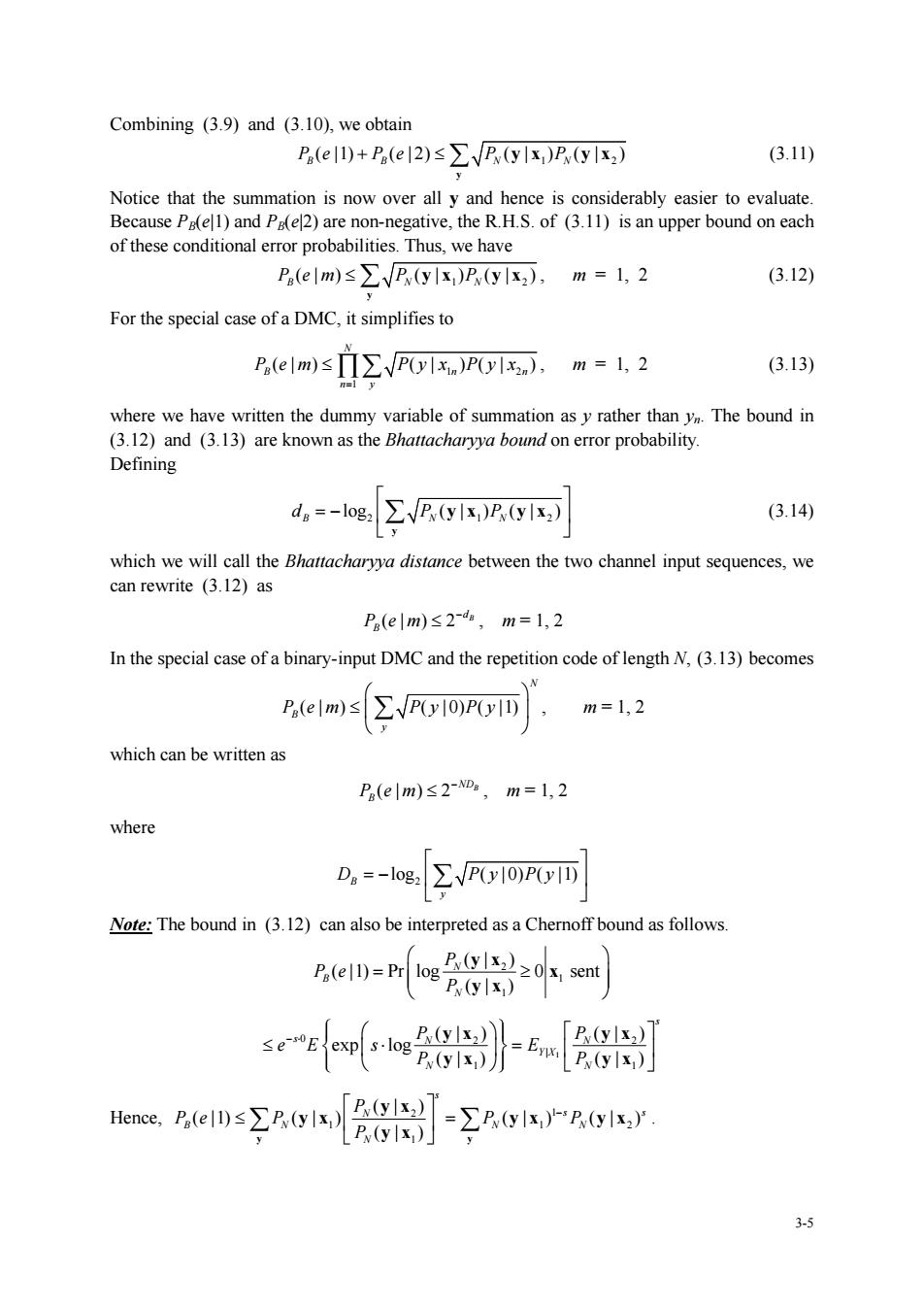正在加载图片...

Combining (3.9)and (3.10),we obtain P.(eIl)+P.(el2)≤∑P,(yIx)R(yIx2) (3.11) Notice that the summation is now over all y and hence is considerably easier to evaluate. Because Pa(el)and P(e2)are non-negative,the R.H.S.of (3.11)is an upper bound on each of these conditional error probabilities.Thus,we have P.(elm)sP(ylx)P(ylx2).m 1.2 (3.12) For the special case ofa DMC,it simplifies to P(em)≤Π∑√(yx)P(y川xa),m=L,2 (3.13) where we have written the dummy variable of summation asyrather than y The bound in (3.12)and (3.13)are known as the Bhattacharyya bound on error probability. Defining da=-log P(ylx)P(ylx2) (3.14) which we will call the Bhattacharyya distance between the two channel input sequences,we can rewrite (3.12)as Pa(elm)≤2,m=l,2 In the special case of a binary-input DMC and the repetition code of length N.(3.13)becomes P.(elm)s∑√PylO)PyI西,m=1,2 which can be written as Pa(elm)≤2o,m=L,2 where Da=-log∑P(y10)P(y) Note:The bound in (3.12)can also be interpreted as a Chernoff bound as follows. seE exps-logw1s2」 P(ylx.) -.(yx) hems.msy 35 3-5 Combining (3.9) and (3.10), we obtain 1 2 ( |1) ( | 2) ( | ) ( | ) Pe Pe P P B B NN + ≤ ∑ y y x y x (3.11) Notice that the summation is now over all y and hence is considerably easier to evaluate. Because PB(e|1) and PB(e|2) are non-negative, the R.H.S. of (3.11) is an upper bound on each of these conditional error probabilities. Thus, we have 1 2 (| ) (| ) (| ) P em P P B NN ≤ ∑ y y x y x , m = 1, 2 (3.12) For the special case of a DMC, it simplifies to 1 2 1 (| ) ( | )( | ) N B nn n y P em Py x Py x = ≤ ∏∑ , m = 1, 2 (3.13) where we have written the dummy variable of summation as y rather than yn. The bound in (3.12) and (3.13) are known as the Bhattacharyya bound on error probability. Defining 2 12 log ( | ) ( | ) B NN d PP ⎡ ⎤ = − ⎢ ⎥ ⎣ ⎦ ∑ y y x y x (3.14) which we will call the Bhattacharyya distance between the two channel input sequences, we can rewrite (3.12) as (| ) 2 dB P em B − ≤ , m = 1, 2 In the special case of a binary-input DMC and the repetition code of length N, (3.13) becomes ( | ) ( | 0) ( |1) N B y P em Py Py ⎛ ⎞ ≤ ⎜ ⎟ ⎝ ⎠ ∑ , m = 1, 2 which can be written as (| ) 2 NDB P em B − ≤ , m = 1, 2 where 2 log ( | 0) ( |1) B y D Py Py ⎡ ⎤ = − ⎢ ⎥ ⎣ ⎦ ∑ Note: The bound in (3.12) can also be interpreted as a Chernoff bound as follows. 2 1 1 (| ) ( |1) Pr log 0 sent (| ) N B N P P e P ⎛ ⎞ = ≥ ⎜ ⎟ ⎝ ⎠ y x x y x 1 0 2 2 | 1 1 (| ) (| ) exp log (| ) (| ) s s N N Y X N N P P eE s E P P − ⋅ ⎧ ⎫ ⎪ ⎪ ⎛ ⎞⎡ ⎤ ≤⋅ = ⎨ ⎬ ⎜ ⎟ ⎢ ⎥ ⎪ ⎪ ⎩ ⎭ ⎝ ⎠⎣ ⎦ yx yx yx yx Hence, 2 1 1 12 1 (| ) ( |1) ( | ) ( | ) ( | ) (| ) s N s s B N NN N P Pe P P P P − ⎡ ⎤ ≤ = ⎢ ⎥ ⎣ ⎦ ∑ ∑ y y y x y x y x y x y x